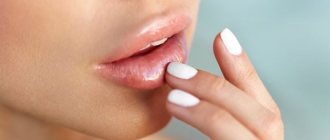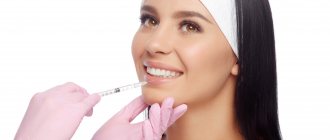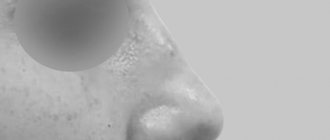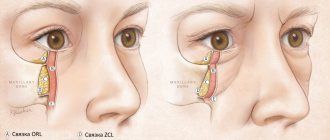Even the procedure of saturating your lips with hyaluronic acid, carried out in an aesthetic medicine clinic, can have side effects. Unfortunately, if you want to give your lips an attractive swelling and additional volume, you need to be prepared for such sacrifices and understand how to reduce swelling after lip augmentation.
Hyaluronic acid actively fills the subcutaneous layers, saturates the lips with moisture, vitamins and nutrients. The life-giving cocktail of the composition not only heals the epidermis and increases the size of the lips, at the same time it stimulates the production of natural hyaluronic acid, which is contained in our body. The rejuvenation process begins not only in the injection area, but also next to the injection area.
What results can you expect after lip augmentation?
Lip augmentation by injection of fillers based on hyaluronic acid allows you to solve several aesthetic problems in a matter of minutes:
- Increase volume.
- Eliminate dryness and flaking.
- Correct asymmetry.
Here it is important to understand how long it takes for lips to heal after augmentation: on average 5-10 days. It is recommended to finally evaluate the result after 2 weeks.
When the recovery period passes, the lips will become moisturized and attractive, while maintaining their natural mobility and sensitivity.
Complications after the procedure
The physiological reaction of the dermis to the introduction of hyaluronic acid under the skin goes away independently, without treatment or additional intervention, without causing harm to the patient’s health. However, in some cases, due to the unprofessionalism of the doctor or the patient’s concealment of data about his state of health (when the desire to be attractive overshadows reason and a sense of self-preservation), unwanted and very serious complications arise:
- The first signs of a dangerous development of the situation are hematomas, redness, papules, swelling that do not go away for 10 days or more. This is a reason to immediately contact a cosmetologist.
- Fibrosis that has developed at the site of filler injection with a superficially located needle requires consultation with a surgeon (subject to surgical removal).
- An incorrectly selected drug can lead to the development of thrombosis, ischemia of the skin area, and rarely to necrosis. In this case, only hyaluronidase, which destroys hyaluronic acid, can save the situation. It must be administered at the first signs of ischemia (numbness, loss of sensitivity, feeling of cold).
- The development of herpetic infection is typical for patients with reduced immunity and requires special therapy.
- Severe itching indicates the toxic effect of the filler on the human body and requires consultation with a gastroenterologist, allergist and dermatologist.
- Rarely there is a reaction of individual intolerance to hyaluronic acid (genetic inheritance)
If the lip augmentation procedure is carried out by a highly qualified specialist, in compliance with all standards of asepsis and antiseptics, and the right choice of drug; If the patient has followed all the recommendations during the rehabilitation period, then nothing else can be expected except pleasure.
Lip augmentation with hyaluronic fillers is modern, safe and effective. You can get detailed information about the procedure at a consultation with a cosmetologist at the aesthetic medicine clinic Soho Clinic (Moscow).
Possible consequences of lip augmentation with hyaluronic acid
To enlarge the lips, the cosmetologist injects the drug to a depth of approximately 3-4 ml. Fillers based on hyaluronic acid are biocompatible and absolutely safe, because... it is produced by our body. The risk of any complications is minimal.
What you might encounter:
- Individual intolerance and allergic reactions.
- Edema.
This is a normal reaction of the body to intervention. It goes away within a few days. - Bruise.
It is not dangerous and also goes away within a few days. - Lumps in the lips.
They may arise if the patient does not comply with the recommendations of the cosmetologist after the procedure. Less often due to a specialist error during the procedure.
Knowing what you can and cannot do after lip augmentation , you will avoid unpleasant consequences and shorten the recovery period.
Fibrosis and compaction - complications after lip contouring
In the first days after the injection of fillers, lumps may appear at the injection site, this is due to the fact that the substance has not yet had time to distribute evenly. Sometimes it happens that a hematoma (bruise) appears due to damage to a vessel. Within a week, it usually resolves, but if the cause of the lump is fibrosis, then the situation is much more complicated and requires your close attention.
Why does fibrosis occur?
The distribution of fillers in the lip occurs gradually, and the effect can last up to 12 months. Immediately after administration of the drug and during the first week, balls are felt under the skin, which dissolve on their own. Clots are nothing more than drops of filler, which is quite natural. Fibrosis is an unpleasant complication when connective tissue grows with the appearance of scar changes.
One of the obvious reasons for the formation of fibrosis is the rejection of a foreign substance by the body . In this case, a well-chosen injection solution can solve this issue. But only a professional cosmetologist can determine the dosage and prescribe the necessary drug that will not aggravate the situation. The doctor will also tell you what care is suitable after lip contouring in your case.
Unobvious reasons for the formation of fibrosis include:
- inexperience of the cosmetologist;
- violation of sanitary norms and rules;
- mechanical damage to the walls of blood vessels;
- counterfeit or low-quality filler;
- violation of the technology and technique of drug administration;
- incorrectly selected dose of the administered substance.
Rehabilitation after lip contouring
Fibrous changes after filler injection can occur anywhere on the face, but a particularly favorite area for localization of compactions is the upper lip. This is due to the fact that the skin here is extremely sensitive, delicate and thin. Swelling may not even arise from the filler, but simply from trauma to the skin with a needle.
Seals on the lips cannot be corrected with makeup. Fibrosis is noticeable to the naked eye, and you won’t be able to hide lumps with lipstick and gloss; rather, on the contrary, you only focus attention on this area. It is possible to get rid of fibrosis in one of two ways: surgical or conservative. In the first case, surgical intervention will be required, and in the second, an external agent with collagenase enzymes. The operation is an extreme measure, which is usually used to extract biogel; most often, gentle methods can be used.
What not to do after lip augmentation
A cosmetologist will definitely tell you how to care for your lips after the procedure. Compliance with the recommendations is especially important during the first two weeks, because... this greatly affects the result.
It is forbidden:
- Take a hot bath, shower.
- Visit the sauna, bathhouse, solarium.
- Drink hot drinks.
- Take medications that affect blood clotting.
- Drink alcohol and smoke.
- Paint.
- Apply creams and ointments. Exception: those recommended by the cosmetologist after the procedure.
- Actively move your lips - stretch, press, stretch, strain, open your mouth wide, etc.
- Visit the dentist.
- Press on lips.
- Engage in sports and heavy physical activity.
- Touch surfaces with your lips that you are not sure are clean, because... high risk of infection.
- Kiss.
Rehabilitation period
The rehabilitation period after lip augmentation lasts no more than three days. Immediately after the procedure, the following symptoms of discomfort may be observed:
- flying, low-intensity pain at the injection site of hyaluronic acid, as a result of the reaction of the nerve endings of the skin to interaction with the filler;
- the appearance of hematomas due to the patient’s very delicate and sensitive skin or due to excessive force during puncture on the part of the doctor;
- redness - reaction of dermal vessels (dilation) to the injected filler;
- small papules occur if the needle was too superficial when injecting hyaluronic acid into the skin;
- swelling or puffiness is a natural reaction to the introduction of an “extra” volume of hyaluronic acid, which can attract moisture, under the skin;
- a blurred contour after lip augmentation is a consequence of temporary lability (mobility) of the distributed gel (until it stably occupies all the subcutaneous voids of the main substance).
These phenomena are a natural response of the dermis to a violation of its integrity. They go away on their own and do not require treatment. Since an injection is a mini-injury, inflammation can, as a rule, be avoided, but swelling after the injection persists for about two or three days. You can minimize unpleasant consequences by choosing the right filler. Otherwise, after lip augmentation, you must follow the recommendations of a cosmetologist:
- For the first time (2 weeks), you need to exclude decorative cosmetics from everyday use. It may be of poor quality or expired, causing allergies or secondary infection.
- You should not lick your lips or constantly touch with your hands. Possible peeling can significantly spoil the visual effect of smooth lips and lead to cracks.
- You should not actively move your lips: talk a lot, stretch your lips out, smile - this can lead to displacement of hyaluronic acid.
- It is recommended to sleep only on your back, in no case on your side or stomach, face down (this provokes a mechanical shift of the filler).
- It is not recommended to visit the sauna for two to three weeks, since profuse sweating can bring with it an inflammatory reaction to salts and other skin irritants (ammonia, urea) present in the secretion of the sweat glands. In addition, high temperatures promote a rush of blood to the facial skin, which can cause cracks in the mucous membrane of the lips, artificially enlarged with filler.
- You cannot swim in the pool for a month. Chlorinated (disinfected with chemicals) water causes irritation and inflammation of the lips.
- It is recommended to limit physical activity and sports. Sweating, risk of injury, secondary infection - all this can result from such activities.
- You need to follow the correct diet. Nothing spicy, salty, or irritating to the lips, at least in the first two weeks.
- For the same reason, you should not drink alcohol or smoke. Not only will the lips be attacked by toxic substances, but the human body will also react to intoxication, aggravating the course of the rehabilitation period (fever, dyspepsia with dehydration, nausea).
- You cannot massage your lips yourself. By doing this, you can disrupt their shape, destroying the symmetry of the filler distribution.
- You should not drink hot tea or coffee, as this can cause burns to the mucous membranes and damage their integrity.
- Avoid flying during the first month after the intervention: pressure at altitude has an unpredictable effect on the gel filler.
- It is advisable to minimize possible contacts with virus carriers or patients with influenza, acute respiratory viral infections, or acute respiratory infections.
If the rehabilitation period is delayed or there is no positive dynamics in the negative symptoms that appear after lip augmentation, you should consult a cosmetologist.
Recommendations after lip augmentation can be not only prohibitive, but also permissive. How can you help sponges recover faster?
- Swelling is well relieved with cold compresses. In this case, you need to ensure the sterility of the surface that will come into contact with the lips.
- In addition, the cosmetologist can prescribe you special masks to relieve discomfort.
Gymnastics
Gymnastics is appropriate only after complete recovery. Not earlier than 2 weeks after the injection.
How to do:
- Pull your lips out with a tube.
- Stretch as wide as possible.
- Compress.
- Sing vowel sounds.
Gymnastics are performed 2-3 times a day for 3-4 minutes. A specialist will show you specific exercises.
How long does the result last?
The results last from several weeks to several years. On average from 4 to 18 months.
Duration depends on:
- individual characteristics,
- the chosen drug,
- compliance with the recommendations of a cosmetologist,
- number of procedures (the result of each subsequent procedure lasts longer).











